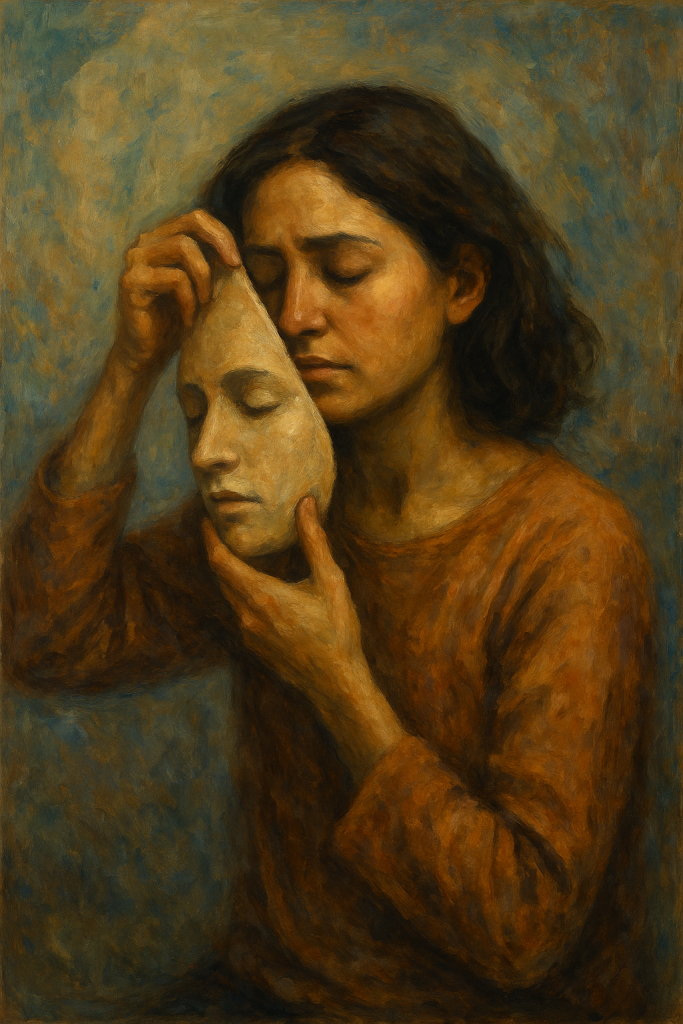Unmasking the Soul: Time to Break Free from Survival Mode
“We suffer not because we are broken, but because we forgot who we are.”
Many of the identities we carry are not our truth, but adaptations—crafted to keep us safe, loved, and accepted. Rooted in childhood experiences and reinforced by unconscious beliefs, these false selves can quietly shape our lives and keep us stuck in cycles of striving and self-doubt.
Blending yogic wisdom with modern psychology, this article explores how we mistake survival strategies for the self—and how to begin gently unraveling them. Through reflection and practice, it invites us to remember the wholeness that was never lost, but only forgotten.

The False Self and the Hidden Truth
In a world built on adaptation and survival, most of us carry a quiet ache: the sense that who we are is somehow not quite who we were meant to be.
We shape our lives around the need to belong, to feel safe, to be accepted. And in doing so, we often become someone else. Not in a conscious way—but gradually, moment by moment, belief by belief, we assemble an identity from the times we felt unsafe being ourselves.
This is the false self. Not false because it’s fake, but because it’s incomplete. It’s the part of us built to survive, not to thrive.
And beneath it all lies a question that yoga, psychology, and the soul all ask in their own way:
Who am I underneath what I’ve become to survive?
Yoga philosophy offers a simple but radical premise: much of our suffering comes not from life itself, but from ignorance—from forgetting who we truly are. This ignorance (avidya) gives rise to attachment, false identity, and mental distortions that keep us spinning in cycles of self-doubt, striving, and subtle despair.
But before we can come home to the truth, we must understand the map we’ve been following—the one drawn in childhood, etched into the body, and mistaken for who we are.
Identity as a Survival Map
What we often call our “personality” is, in many cases, a protective adaptation.
We don’t just become who we are. We become who we needed to be to feel safe. To be loved. To be seen. To avoid shame or punishment.
Identity, then, is not always authentic—it can be a kind of armor. A mask woven from the moments when we felt we had to hide, shape-shift, or overperform in order to be accepted.
Think of it like this:
Our identity is often a costume stitched together from moments when we didn’t feel safe to be ourselves.
We become the reliable one. The smart one. The strong one. The helper. The peacemaker. The achiever.
And slowly, without realizing, we attach to those roles—not because they are true, but because they once protected us.
Underneath each identity is a limiting belief:
“I must be perfect to be worthy.”
“If I’m not helpful, I’ll be rejected.”
“If I show weakness, I’ll be abandoned.”
These beliefs aren’t facts. They’re survival maps. Once useful, but no longer true.
Reflection prompt: What belief or role helped me feel safe when I was young? Is it still serving me today—or is it now limiting me?
The Perfectionist: A Story of Conditional Love
Let’s bring this to life with a familiar example: the perfectionist.
It often begins in childhood. Praise and love are tied to success, usefulness, or good behavior. Maybe mistakes were punished. Maybe emotions were inconvenient. Maybe love was available—but only when earned.
So the child adapts: If I do everything right, I’ll be safe. If I’m perfect, I’ll be loved.
Over time, a personality forms. High-functioning. Hard-working. Always ahead. Driven—but driven by fear. What looks like excellence is often just efforting for love.
In adulthood, this adaptive self turns inward. The inner critic sharpens. Rest feels unsafe. Joy feels indulgent. Self-worth gets measured by productivity. And eventually—burnout, anxiety, and the quiet ache of never feeling “enough.”
Yoga names this pain as dukkha—the suffering that arises when we forget who we are, and chase worth where it cannot be found.
🌬 Reflection prompt: Where in my life am I still trying to earn love through effort?
The Mind’s Patterns and the Self We Mistake for Truth
Yoga’s map of the mind is ancient, but stunningly modern. Its wisdom aligns with trauma theory, parts work, and modern neuroscience.
Let’s simplify some key terms:
- Avidya – Not seeing clearly. Forgetting who we are beneath our roles and reactions.
- Asmita – Mistaking the ego, the story, or the role for the self.
- Vrittis – The swirling thoughts, stories, judgments, and fears that cloud perception.
- Samskaras – Emotional grooves. Habitual patterns laid down through repetition and experience.
These are not pathologies. They are normal. Human. Expected.
But they create suffering when they are mistaken for truth.
It’s like looking at life through a smudged lens—everything gets distorted.
We don’t see life clearly. We don’t see ourselves clearly.
As Patanjali writes:
“Yoga is the stilling of the fluctuations of the mind.” (Sutra 1.2)
Only when the mind quiets can the self be remembered—not built, but remembered.
Working With Limiting Beliefs: From Pattern to Presence
So how do we begin to work with these beliefs—not to fight them, but to soften them?
Here’s one pathway, inspired by both Dr. Jeffrey Schwartz’s neuroscience model and yoga’s inner technology:
1. Relabel – See the Thought
The first step is awareness. This is a thought, not a fact. When you see the belief, you create space from it. You stop being inside it—and start observing it.
Prompt: Can I name the belief, without identifying with it?
2. Reattribute – Name the Root
Understand the origin. This belief isn’t your essence—it’s your adaptation. Often formed before you had language. A map drawn by fear, not truth.
As Gabor Maté says:
“The question is not why the addiction, but why the pain?”
Prompt: When did this belief first show up? What was I trying to protect myself from?
3. Refocus – Return to Now
Don’t just think—move. Shift your attention. Use breath, movement, journaling, or creative expression to anchor yourself in the now.
Yoga offers tools here:
Asana (movement), Pranayama (breath), and Dharana (focused attention).
Prompt: What would bring me into my body right now?
4. Revalue – Reflect Honestly
Ask: What did this belief give me? And what did it cost me?
Two columns:
This identity helped me…
This identity blocked me…
Prompt: Am I ready to release what no longer serves, even if it once saved me?
5. Recreate – Choose Again
Who are you becoming now—not from fear, but from choice?
What would life look like if it were shaped by your values, not your fears?
Prompt: What part of me is ready to lead from truth, not protection?
Practices for Reclaiming the True Self
Yoga doesn’t ask us to reject the mind—it teaches us how to relate to it with wisdom.
Some tools:
- Svadhyaya (self-inquiry): Study yourself. Journal, reflect, witness your patterns without judgment.
- Dhyana (meditation): Drop beneath identity. Touch the part of you that is simply aware.
- Vairagya (non-attachment): Gently loosen your grip on the old roles and labels.
- Asana & Pranayama: Use movement and breath to regulate your nervous system—so you can access clarity, not just reaction.
These practices aren’t about self-improvement. They’re about self-remembrance.
Remembering Who You Are
At the heart of this journey is a truth that yoga and psychology both whisper:
We suffer not because we are broken—but because we forgot who we are.
We think we are the story, the belief, the mask. But beneath that is something whole, wise, and free. A self that was never lost—only hidden.
You don’t have to earn your worth. You never did.
As Rumi wrote:
“Try not to resist the changes that come your way. Instead, let life live through you.”
So maybe the question isn’t “Who am I?”
Maybe the question is:
Who was I before the world told me who to be?
Let yourself be still enough to hear the answer.
Trust life. Let love lead you on your journey home.
